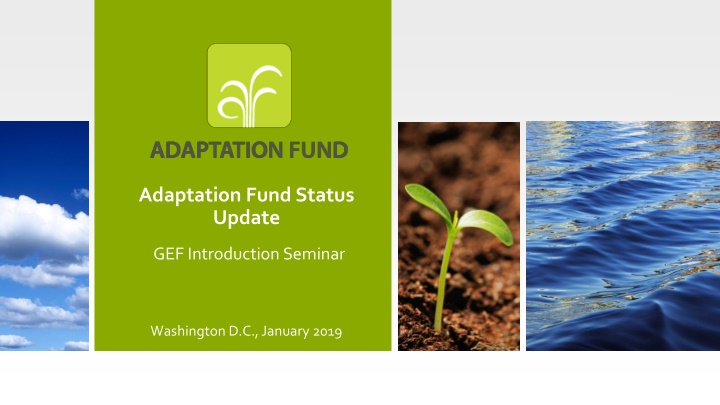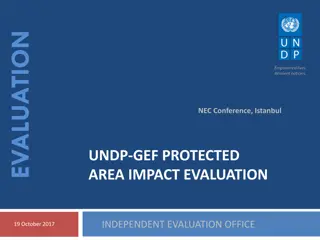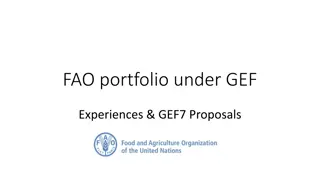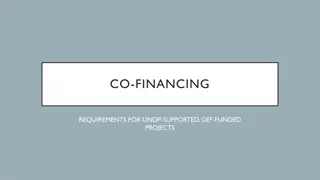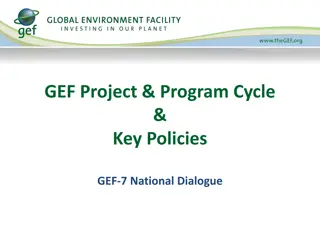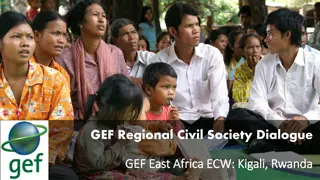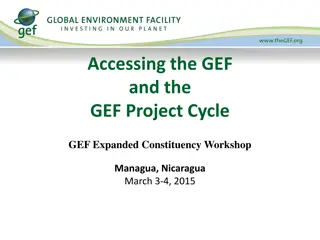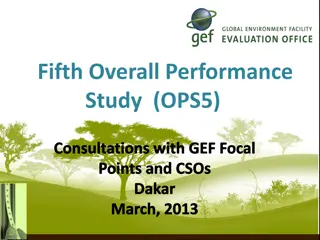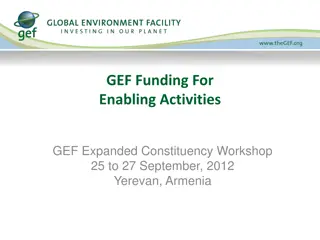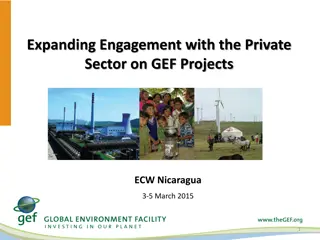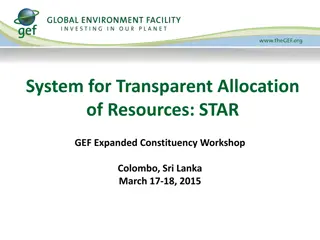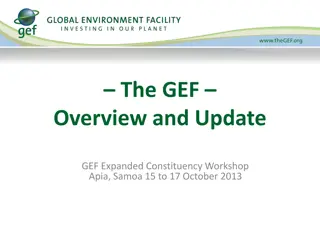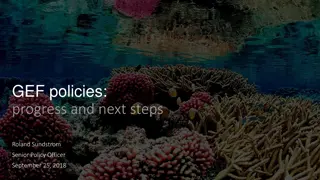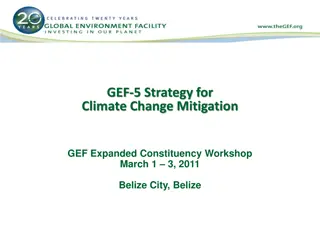Adaptation Fund Status Update: GEF Introduction Seminar Highlights
The Adaptation Fund, since its inception, has mobilized over US$864 million in resources, with a significant portion from various contributions. With allocated funds for projects in 81 countries, including LDCs and SIDS, the Fund supports 80 adaptation and resilience projects benefiting around 5.8 million individuals. The number of direct access entities has grown, enabling more efficient fund utilization. Additionally, the Fund plays a crucial role in supporting the Paris Agreement objectives and NDC implementation efforts.
Download Presentation

Please find below an Image/Link to download the presentation.
The content on the website is provided AS IS for your information and personal use only. It may not be sold, licensed, or shared on other websites without obtaining consent from the author.If you encounter any issues during the download, it is possible that the publisher has removed the file from their server.
You are allowed to download the files provided on this website for personal or commercial use, subject to the condition that they are used lawfully. All files are the property of their respective owners.
The content on the website is provided AS IS for your information and personal use only. It may not be sold, licensed, or shared on other websites without obtaining consent from the author.
E N D
Presentation Transcript
Adaptation Fund Status Update GEF Introduction Seminar Washington D.C., January 2019
Experience on funding Climate Adaptation Since inception, the Fund has mobilized ca. US$ 864* million in resources. US$ 199 million came from CER proceeds and US$ 667 million from developed countries contributions. The resources allocated so far amount to US$ 532 million in 81 countries, of which 28 are LDCs and 18 SIDS. The Adaptation Fund currently funds 80 concrete, localized adaptation and resilience projects in 81 vulnerable countries with ca. 5.8 million direct beneficiaries. Its projects are effective, flexible and scalable, and can be replicated in other communities.
Since 2010 the Fund has approved US$ 532 million for 81 countries Projects under development (December 2018): 25 country project totaling US$ 150.4 million 20 regional projects totaling US$ 185 million
The number of direct access entities has increased 46 Implementing Entities 28 NIEs (46% LDCs, SIDS, 10 in Africa) New: Tanzania and Niger 6 RIEs 12 MIEs Direct Access, whereby a country can access funds directly from the AF and other funds adopting similar modality to manage adaptation/mitigation projects, requires an accredited National Implementing Entity meeting the funds fiduciary standards, environmental and social safeguards and gender policy
AF contributes to the implementation of the Paris Agreement Paris (2015): (COP 21, CMP11)The Adaptation Fund may serve Paris Agreement Marrakech (2016): (CMA 1) The Adaptation Fund should serve the Paris Agreement Bonn (2017): (CMP 13) The Adaptation Fund shall serve the Paris Agreement Katowice (2018): (CMA 3) The Adaptation Fund serves the Paris Agreement since January 1st, 2019, and continues to serve the CMP until the share of proceeds under Article 6, paragraph 4, of the Paris Agreement becomes available (CMP 14).
AF CONTRIBUTION TO THE ADAPTATION OBJECTIVE OF THE PARIS AGREEMENT The Adaptation Fund is already contributing to the adaptation objectives of the Paris Agreement and to the implementation of adaptation actions included in the NDCs of developing countries by financing its portfolio of concrete adaptation projects and programmes.
ADDED VALUE OF AF SERVING THE PARIS AGREEMENT Achieving the PA goal of balancing funding for adaptation and mitigation in developing countries Article 9.4: Financing Adaptation must take into account national strategies and priorities of the most vulnerable countries with capacity constraints, such as LDCs and SIDS The Agreement attributes to adaptation a share of the proceeds of the Sustainable Development Mechanism it has established (Articles 6.4 and 6.6). This may be a market mechanism similar to the clean development mechanism.
Medium-term Strategy (MTS): approved in October 2017 Fund's purpose is aligned with goal of Paris Agreement, SDG 13 Focus remains on the most vulnerable Fund has delivered: concrete action, Innovation for adaptation valuable learning Inclusion of new pillars into concrete projects + targeted support
MTS Implementation Plan: approved in March 2018 In addition to existing ones, new funding modalities: Action Window for enhanced direct access : US$ 20 M per year (>10 grants) Scale-up microgrants: US$ 200,000 per year (10 grants) Innovation Large grants (<US$ 5 M) for rolling out, scaling up innovation: US$ 90 M over 5 years (>18 grants) Micro-grants (<US$ 250 k) for encouraging new innovation, creating evidence base: US$ 16 M over 5 years (>64 grants) Learning and sharing South-South learning microgrants (<US$ 150 K) for sharing practices, lessons (ca. 15 grants)
MTS Implementation Plan: approved in March 2018 New resources and assistance: Action: Community of Practice for NIEs: online platform, workshop Country exchanges for NIEs Learning and sharing: Publications showcasing best practice / case studies Showcasing best practice on direct access Lessons learned from accreditation, reaccreditation Knowledge Management toolkit for lessons learned Knowledge Management toolkit for RBM E-learning course on accreditation
Evaluation: Phase II (2017-2018) portfolio Conclusions Relevance: AF portfolio is in alignment with mandate and strategic priorities Effectiveness: AF is making progress toward all seven outcome areas of the AF Strategic Results Framework. Projects have and do contribute to strengthening resilience at national and/or local levels Efficiency: AF is efficient in managing accreditation and project cycle processes Results and sustainability: AF has increased developing countries access to adaptation finance. However, this is limited by the scale of financing available.
www.adaptation-fund.org/ @adaptationfund
Establishment of the AF evaluation function Adaptation Fund has established an evaluation function through a Technical Evaluation Reference Group (TERG) to: Evaluate: Independently commission the evaluation of the relevance, effectiveness, efficiency and sustainability of the Fund overall operation projects and programmes implementing entities Advise: Set minimum evaluation standards with the Fund Oversee: Provide quality control of the minimum evaluation requirements Implementing entities will remain responsible for commissioning evaluations (MTE, TE) of their projects/programmes Chair of the TERG recruited and other members ongoing Photos: UNDP Turkmenistan
